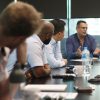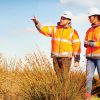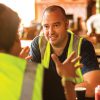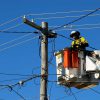With Australia’s reliance on technology growing, demand is increasing for more robust and readily available telecommunications networks across the retail, residential, corporate and government sectors.
As part of our work to ensure the supply of available networks meets voice and data demand, our Visionstream Wireless Projects team completes new builds and upgrades of telecommunication tower structures across Australia, including remote sites in the outback.
These large tower projects come with their own unique challenges from site acquisition to civil and structural engineering to complex system integrations, but safety is always our first priority regardless of where our teams are working or how tight the deadline.
Focusing on our CRPs during the design phase of a project and using ‘above the line’ controls will eliminate risks and ensure our work practices are safe.
To get a sense of the specific safety challenges of working on towers, Connect spoke to Peter Hughes, National Construction Manager in the Wireless business and Steve Dyer from SHEQ.
Q What are some of the most challenging locations the team works across?
 Steve: The nature of our business means our project work could be anywhere! From city rooftops, along your streets, within buildings or on mountain tops. Sites can be in regional areas or anywhere in outback Australia. The team performs large complex projects that can take years of planning to relatively small, short-duration work that take a few weeks of planning and construction.
Steve: The nature of our business means our project work could be anywhere! From city rooftops, along your streets, within buildings or on mountain tops. Sites can be in regional areas or anywhere in outback Australia. The team performs large complex projects that can take years of planning to relatively small, short-duration work that take a few weeks of planning and construction.
Q What are some of the major safety challenges with construction across these locations?
 Peter: Every site is different, but there are some common challenges. The first is access: getting to the site and securing the right equipment to carry out the work – whether it’s stairs and ladders, or plant such as elevated work platforms and cranes.
Peter: Every site is different, but there are some common challenges. The first is access: getting to the site and securing the right equipment to carry out the work – whether it’s stairs and ladders, or plant such as elevated work platforms and cranes.
A second challenge is the driving itself: navigating unsealed roads and tracks and ensuring there are adequate communications travelling to, from, and while working in remote locations. A third challenge is site set-up: managing vehicle and pedestrian traffic, street closures and night work, and ensuring contingency plans are in place.
Q What training is required for the different roles on our builds?
 Steve: A wide range of training is required, including working at heights, radio frequency awareness, four-wheel drive training and traffic management implementation training. There is also high-risk training for rigging, plant operations, tower rescue, electrical and service location awareness.
Steve: A wide range of training is required, including working at heights, radio frequency awareness, four-wheel drive training and traffic management implementation training. There is also high-risk training for rigging, plant operations, tower rescue, electrical and service location awareness.
Q What are the fundamental safety considerations for the team?
 Steve: It’s critical that we understand and capture all the risks and hazards associated with the scope of work before the job starts – and develop a plan for managing them during the design phase.
Steve: It’s critical that we understand and capture all the risks and hazards associated with the scope of work before the job starts – and develop a plan for managing them during the design phase.
Once on-site work begins, it’s about making sure everything is in place to meet our health and safety requirements. That includes ensuring our people are trained and have the necessary documents and tools to complete the work safely.
It really is a team effort and everyone from field managers to SHEQ to internal technicians, riggers and sub-contractors understand the risks they face before a job is performed and all do great work to keep everyone safe.
Q Are there some innovations the team has rolled out to make sites safer?
 Peter: We have a great example where the team designed and implemented a mechanised aid to reduce manual handling of batteries – a significant safety hazard.
Peter: We have a great example where the team designed and implemented a mechanised aid to reduce manual handling of batteries – a significant safety hazard.
 Steve: In general, the CRPs have helped to make sites safer by requiring people look in detail at the tasks being done with the highest risks, ensure compliance and, where practicable, to work ‘above the line’ in the hierarchy of control. The use of exclusion zones and scaffold catch decks at outdoor unit locations are other examples of steps that allow our technicians to work safely on towers. While working at height all our tools are tethered to ensure they don’t drop.
Steve: In general, the CRPs have helped to make sites safer by requiring people look in detail at the tasks being done with the highest risks, ensure compliance and, where practicable, to work ‘above the line’ in the hierarchy of control. The use of exclusion zones and scaffold catch decks at outdoor unit locations are other examples of steps that allow our technicians to work safely on towers. While working at height all our tools are tethered to ensure they don’t drop.
Q How do we ensure all our people and contractors are adhering to our strict safety systems?
 Steve: It’s a multi-layered process: checking lead indicators and carrying out safety audits on site, as well as sharing critical safety messages through pre-start meetings and tool box talks. We have field managers on site for start-up and high risk works and we always ensure full compliance with Visionstream’s and client requirements
Steve: It’s a multi-layered process: checking lead indicators and carrying out safety audits on site, as well as sharing critical safety messages through pre-start meetings and tool box talks. We have field managers on site for start-up and high risk works and we always ensure full compliance with Visionstream’s and client requirements
 Peter: We have a culture where leaders and teams take initiative. That could be a team leader using a pre-start to ask everyone on site for input into the risks and hazards for the day ahead. Or it could be something as simple as asking others on site for help with manual handling.
Peter: We have a culture where leaders and teams take initiative. That could be a team leader using a pre-start to ask everyone on site for input into the risks and hazards for the day ahead. Or it could be something as simple as asking others on site for help with manual handling.
Main image above: Contractors working on our Wireless Project team scale a tower in regional Australia.








